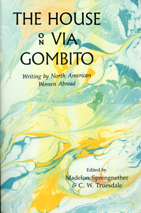Borgo Pinti, the street where the Women’s B&B is located, runs into the center of Florence in one direction, and in the other, toward the northern edge, toward Fiesole. Heading in that direction, you can look down narrow Borgo Pinto and in clear weather spy the clock tower of Fiesole rising up from the hills. From many sources, some casual, some intentional like the Museo di Firenze Com’Era (the Museum of FLorence As It Used To Be), I’ve gathered that Borgo Pinti originally designated a zone outside the city walls. Old maps describe Florence like a spiky star, with city walls zig-zagging out toward bastions and in toward streets and houses. Between the bastions stood huge wooden gates which could be closed at night or in case of siege.
Antique Florence was a city dominated by families with wealth and power who built huge palazzi or palaces with enormous portals crowned by their coat of arms. But the Catholic Church also amassed earthly might: many sons of wealthy families became bishops and eventually popes–as was true throughout the upper half of Italy. If the Church said NO to building residences/hospitals for “penitente” or unwed mothers within the city walls–sacred space, after all–then such ospedale were constructed outside the walls. Borgo Pinti, beyond the walls, became such a site, with many homes and hospitals for unwed mothers. Pinti is a contraction of “penitente” or the penitent.
I think about this as I roam the neighborhood, now dotted with antique palazzi turned to modern use: one houses the faculty of architecture for the University of Florence, another a military establishment devoted to the wounded. Some of the more enormous gardens and palazzi have been acquired by hotels. One of the more subdued, called the Mona Lisa, shares the enormous inner garden with the palazzo which houses the Women’s B&B.
In the middle 1990s, I was lucky enough to be invited by friends to hold a travel memoir class in their fabulous apartment not far from Borgo Pinti. Were there perhaps eight or ten of us who pulled chairs and a sofa into a circle and wrote about breaking high heels on cobblestones or falling ill after eating Mexican oysters? I can’t recall our exact number, but we ranged in age from relatively young to older. One of the youngest flew over with me from the Twin Cities. With incredible luck because there was a railroad strike, we hitched a ride from Rome with Helen, an Iowan who’d acquired, then shed an Italian husband, kept their place in the Tuscan hills, and had business beyond Florence. We stopped midway, thank heavens, because Helen drove like a maniac. Panting, drained of color, Margaret and I were almost sick with fear and speed. We admired Helen’s collection of American quilts, sampled olive oil made from “her” olives, and hit the Autostrada for the final zip into Florence.
Margaret stayed at the Mona Lisa. As we gathered for our first morning of writing, she arrived with a sparkle in her eyes. She had met Livio who worked the desk at the Mona Lisa. “What, you are unhappy?” he intuited as she approached the desk after viewing the room she’d been assigned. Fingers raised in an encouraging gesture, “Give me twenty-four hours. I will make it right.” In fact it didn’t take that long: not only did he direct her to La Pergola theater, just behind the hotel, where James Galway was giving a concert, but after she returned, he signed off from the desk and they walked the mystery of Florence under full moon. Her sparkling eyes suggested just what had happened under that magical luna.
Staring up into the Mona Lisa’s coffered ceiling, which must have been the entry courtyard where carriages pulled up, I decipher tiny little frescoes illustrating Latin sayings: each square of the coffer contains such things as “Fideli tuo silentio” with a finger pressing lips together. Or a pair of bellows to fan the fire with the saying Accipit Reddit Que. Silence with Heat was the essence of Peg’s message. She told us almost nothing of that moonlit walk but her swagger and sparkle suggested warmth, much warmth. Of course, my rude translations of the sayings may be off kilter. Who knows what precisely they suggest–not unlike the whole history of Borgo Pinti.


Leave a Reply